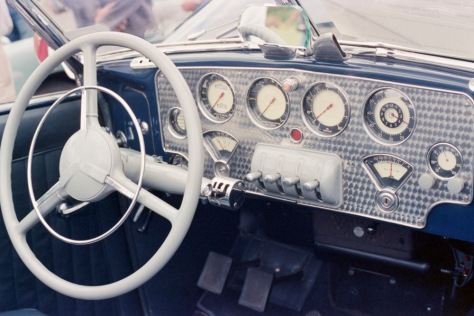A while ago a friend of mine asked me to shoot a roll of Tri-X through my Contax G2 so he could see how it performed in low-light situations, as he was thinking about getting one himself. I took a walk around my neighborhood one evening in the spring, put a roll through the camera, and these are some of the results.
One thing I notice about the shots I’ve been taking with the G2 is that my composition has been freer, less formal and less insistent on everything being nice, tidy, plumb and square. I’ve been shooting more off-angle shots and I don’t know if that’s because I’m shooting hand-held, eye-level, or because I’m trying out more ‘grab shots’ where the camera isn’t even really being brought to my eye, I’m just aiming and trusting the auto-focus. I know in the past I would have found a lot of these off-angle ‘grab shots’ objectionable and they’d have gone straight to the reject pile. But I’m reconsidering them now and I’m starting to like them. Well, maybe more appreciate them for what they are, and not reject them out of hand.

Cars at night are interesting. Depending on how you shoot them, they can be sharp, they can be blurred, or they can even disappear, leaving behind only the light trails of their head and tail lamps as proof they were once there.
The BMW was stopped fully at the traffic light when I started the exposure, but the SUV next to it was in the act of stopping, and the car turning onto 14th Street was in continuous motion.

Cars and people have to co-exist on city streets. Here a pedestrian follows a speeding car through the intersection, hoping to make the other side before the change of the light.

People in low light are a similar problem – they don’t ever really sit still. Combine that with needing to use large apertures with shallow depth of field in low light, and the requisite slow shutter speeds, and you have a recipe for blur. This was something else I used to always find objectionable; blurry people. Now, I think of it more as a sign of our humanity and our alive-ness.

This isn’t to say we always need to be in continuous motion – quiet contemplation in a sea of motion is often called for and a needed respite.

Architecture at twilight is in some ways easier to shoot because the subjects aren’t moving. But that still has challenges because the contrast range of dim exteriors and bright interiors, combined with hotspots from outside spot lights, can be just as difficult to balance.

The fun thing about these lighting situations, though, is that it sets up the viewer to make a psychological interrogation of the building- you are literally being pulled into the interior of the space to examine, investigate and interpret something illuminated from within that in daylight is muted if not hidden.





































